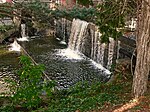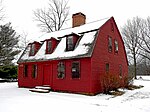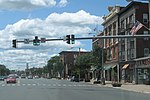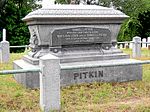Gilman-Hayden House
East Hartford, ConnecticutGeorgian architecture in ConnecticutHouses completed in 1784Houses in Hartford County, ConnecticutHouses on the National Register of Historic Places in Connecticut ... and 1 more
National Register of Historic Places in Hartford County, Connecticut

The Gilman-Hayden House is a historic house at 1871 Main Street in East Hartford, Connecticut. Built in 1784, it is a good local example of Georgian architecture, and is also notable as the home of Edward Hayden, a diarist of the American Civil War. It was listed on the National Register of Historic Places in 1984.
Excerpt from the Wikipedia article Gilman-Hayden House (License: CC BY-SA 3.0, Authors, Images).Gilman-Hayden House
Main Street,
Geographical coordinates (GPS) Address Nearby Places Show on map
Geographical coordinates (GPS)
| Latitude | Longitude |
|---|---|
| N 41.791666666667 ° | E -72.633611111111 ° |
Address
Main Street 1873
06108
United States
Open on Google Maps









